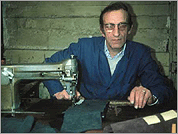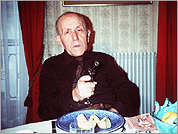|
| French
Film Bears Witness To Wartime Complicity
ALAN RIDING
01/09/01
PARIS, Jan. 8 —
By his own admission, Mosco Boucault was looking for a heroic
father figure in the early 1980's when he began combing Paris
for elderly foreign Jews who had joined the French Resistance.
As a Bulgarian-born Jew whose father had died shortly before
he came to France at 10 in 1956, he felt drawn to these forgotten
Jewish combatants. As an aspiring movie director, he was also
well placed to tell their story, and a version of his own.
| |
 |

|
| Raymond Kojitski, a Parisian
tailor, is a subject of "Terrorists in Retirement." (Mosco
Boucault) |
| |
The immediate result was a screenplay
in which a Frenchman discovers that his dead father had been
an immigrant Jewish fighter executed by the Nazis, a fact hidden
from him by his mother, who had changed the family name to disguise
her Jewish roots, just as Mr. Boucault's surname was changed
from Levy after he moved to France. He even persuaded Simone
Signoret to play the role of the mother.
"But I then thought the actors will
end up assuming the roles," recalled Mr. Boucault, 54, "and
the real people will die without trace." So, instead, begging
Ms. Signoret's pardon, he decided to make a documentary about
the so-called Manouchian Group, an armed unit of Communist
immigrants, mainly Jews from Central Europe, who carried out
assassinations and bombings of Nazi targets in Paris.
Through a handful of survivors, Mr.
Boucault hoped to rescue a crucial piece of Jewish history
and to counter the commonplace notion that Jews did nothing
to resist their Nazi executioners.
"Terrorists in Retirement," which
is to be seen in Manhattan for two weeks beginning on Wednesday
at the Film Forum in the South Village, achieved this and
more. Between the time Mr. Boucault began shooting the 90-minute
documentary in 1982 and its single broadcast on French television
in 1985, it also provoked a heated debate that mirrored France's
growing discomfiture over its wartime role.
The movie focuses on seven Jews,
five from Poland and two from Romania, all Communists, who
were among some 200 members of a "direct action" hit group
called the Immigrant Workers (Main d'Oeuvre Immigr™e), which
was in turn linked to the Communist Party's Francs-Tireurs
et Partisans. Best known by its initials, F.T.P.-M.O.I., the
group was almost alone in 1942 and 1943 in targeting Nazi
officers, hotels, military convoys and even Paris cafes and
nightclubs frequented by the occupiers.
After its leader, Missak Manouchian,
an Armenian poet, and 22 others were arrested in late 1943
and executed on Feb. 21, 1944, the Nazis plastered Paris with
a red poster carrying the photographs of a dozen of them and
denouncing them as "Jewish, Armenian and other stateless terrorists."
After the war, however, the poster became a badge of honor:
Louis Aragon wrote a poem, "L'Affiche Rouge" ("The Red Poster"),
which Leo Ferr™ put to music; two decades later Philippe Ganier-Raymond's
book by the same name helped inspire Mr. Boucault's film.
In the movie, the old combatants, several of them still working
as tailors in eastern Paris, tell the story of their flight
to France in the 1930's and their shock when Stalin signed
a nonaggression pact with Hitler in 1939. As loyal Communists,
they obeyed instructions to accept Germany's conquest of France
in June 1940, but they were also delighted when Hitler attacked
the Soviet Union in July 1941: at last the French Communist
Party was under orders from Moscow to terrorize the Nazi occupation
forces.
Mr. Boucault said that at times it
was hard to follow the men as they excitedly recounted their
guerrilla actions, so he persuaded them to re-enact some dramatic
moments on the streets of Paris, even to the point of having
them wave pistols and hurry down escape paths. "I thought,
'Why not recall the incidents with movements as well as words?'
" he said. "And they really got caught up it in all. I think
they enjoyed going back to those times."
When they came to discussing the circumstances
of the roundup of the group, however, things became more complicated.
There was consensus that they were betrayed by one of their
number, Joseph Davidovitch, who was arrested and tortured
by the Nazis (before being released and shot by the Resistance).
But some survivors also felt the French Communist Party had
sacrificed the unit by refusing to smuggle vital Jewish combatants
out of Paris after the French police began to tail them.
This was certainly the view held by
Manouchian's widow, Melin™e. In the last letter she received
from her husband before his execution, he said that he forgave
everyone except "the one who betrayed us to save his skin
and those who sold us." For her and several others, foreign
Jews who joined the Resistance because "they had nothing to
lose" were not given the same protection as French Communists.
For some, the Communist Party even preferred to have heroes
with more French names than, say, Mitzflicker, Gronowski and
Rayski. "I had wanted to show
that Jews were not only victims," Mr. Boucault recalled, "and
I learned only later of the Communist betrayal." It was this
charge, however, that almost sank his film. After he made
it for the government television channel Antenne-2, the documentary
sat on a shelf until it was finally set for broadcast in June
1985. The French Communist Party, which from 1982 to 1984
had been part of President Franôcois Mitterrand's Socialist-led
coalition, immediately protested.
The channel then sought the view
of the government's High Authority of Audiovisual Communication,
which in turn consulted five Resistance heroes. They criticized
the film, and Antenne-2 canceled it. A fierce debate followed,
with charges of censorship pouring in, including from Ms.
Signoret, who had recorded the voice-over commentary. One
month after originally scheduled, the film was finally shown.
The controversy proved useful. Not
only did the film draw a large audience, but it also threw
the spotlight on neglected Jewish heroes and added momentum
to cautious moves to look afresh at France's wartime record.
Today "Terrorists in Retirement" would no longer provoke discord
here, partly because the Communist Party is now a shadow of
its old self, but, more important, because little remains
of the Gaullist myth that France stood firm against the Nazi
occupiers.
Movies, books and two war-crimes
trials of French collaborators, Paul Touvier and Maurice Papon,
have told a less uplifting story of the deep involvement of
the collaborationist Vichy regime and of the French police
and militia in the deportation of 76,000 Jews from France
to Nazi death camps. Inevitably, though, this new information
has reinforced the image of Jews as victims. With three of
the film's "terrorists" still alive, perhaps it is time for
the documentary to be shown again in France.
Copyright
2001 The New York Times Company
|

